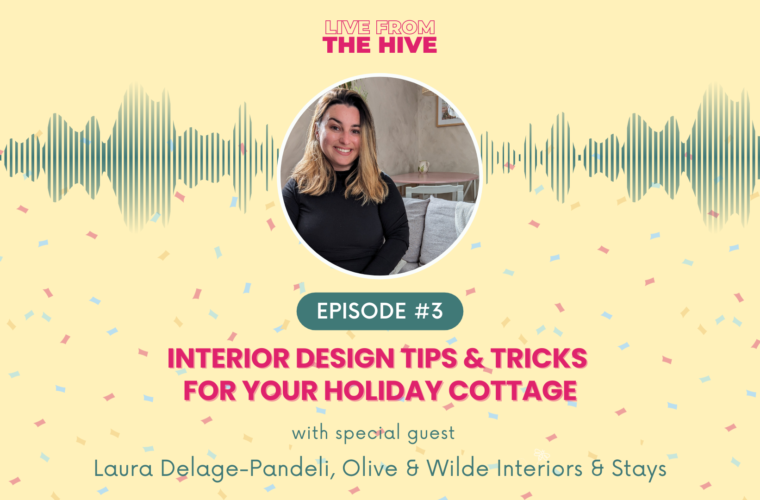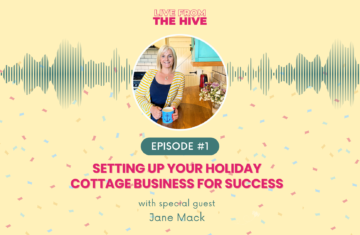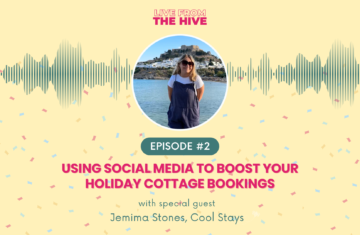So first of all, tell me how you got started in the industry and your role within it.
I’ve been an Airbnb host since 2016 or 2017, so for quite a while now. It all started when I couch-surfed across California in my twenties, where I discovered Airbnb. When I returned home, I decided to rent out an air mattress in my spare room to make some extra money. I was surprised people were willing to pay £50 a night to sleep on an air mattress, and thought it was brilliant!
After buying my house, I renovated the top bedroom to be guest-friendly, which helped cover part of the mortgage as I was living alone at the time. It’s grown from there, and now I have four properties – three in the UK and one in Spain, most of which I manage myself.
So, in addition to being an Airbnb host, you also run an interior design business?
Yes, it developed quite naturally alongside hosting. When I started with Airbnb, I was also doing an online interior design course and really enjoyed it. I decided to continue with my interior design career.
This year, I realised how much impact good design has on the guest experience in holiday lets, including my own. Now, I’m focusing on creating standout Airbnbs through interior design.
It’s valuable to have that perspective as both an owner and a guest, especially with your experience travelling and staying in Airbnbs. You’ve been in the industry for seven or eight years now. How have trends changed during that time, particularly since your early days with Airbnb in California?
The industry has definitely evolved. The Covid pandemic has been a major factor in this change, influencing trends significantly. While people were once content to sleep on an air mattress for £50 a night, I don’t think many would be satisfied with that now. Nowadays, guests are seeking more; they want memorable experiences and to create lasting memories from their stays.
Absolutely, it’s all about creating that experience! With your interior designer hat on, could you share some tips for elevating properties to enhance the guest experience?
It’s crucial to put yourself in your guests’ shoes and consider what you would want if you were staying there. While it’s easy to focus on practicalities as owners, it’s important to think about the overall experience. Consider where your guests might enjoy their morning coffee—focus on those moments. Think about the sunlight, the placement of the coffee machine, and any standout features, like a nice view or lovely trees outside.
Creating special moments through the interiors is key. For instance, I always think about the coffee station: where it’s located, what view guests will have while enjoying their coffee, and where they can sit back and savour that peaceful holiday moment.
Great tips! Many owners are apprehensive about interior design because of the high foot traffic in their properties. It’s essential for any design to balance durability with aesthetic appeal to create those experiences. Do you have any advice on managing both?
I believe it’s crucial to target your property to the right guests. Things will inevitably get damaged, but if you invest wisely from the start, considering how items will be used, you can minimise issues. For instance, ask yourself if a chair is sturdy enough to withstand many guests. If you’ve chosen well, you shouldn’t have to replace large furniture items frequently.
This doesn’t mean you need to spend a lot; it’s about making smart choices. If you’re concerned about stains, using throws can protect your furniture. They can easily be washed or replaced if necessary.
Don’t be afraid to be creative with your design! Not everyone wants plain white IKEA furniture; adding unique pieces from charity shops can enhance the character of your space. Mixing and matching is part of the design process, and it doesn’t have to be perfect. I hope that helps!
Amazing! You’ve done some fantastic things with your properties; they’re not just plain white but really fun. Could you share what you’ve done to make them stand out?
It all comes down to creating memorable experiences. For instance, I use mismatched plates and have a few essential items that are non-negotiable, like a quality mattress and sofa. Those are my high-end pieces. After that, I have fun with paint, wall colours, accessories, and lighting, as these elements are easy to change over time.
For example, if I initially painted a room pink and later grew tired of it, I can easily refresh the space with a new colour, like green. With key neutral items in place, it’s simple to alter the overall look.
I also use wallpaper creatively, considering the type of guests I attract. Many of my guests are active on Instagram, so I design spaces where they can capture great photos. A distinctive wallpaper can provide a perfect backdrop, allowing guests to take memorable pictures they can share and tag, fostering a connection to the property and encouraging them to return.
How crucial do you find attractive interior design for generating bookings?
In today’s market, it’s essential. Guests have become more discerning and are often looking for something different from their own homes. With many properties available online, there’s a tendency to see a lot of generic listings—white house after white house. If your property stands out with bold colours like pink, purple, or green, it’s more likely to catch someone’s attention as they scroll through booking platforms.
Attracting guests in that initial scrolling phase is key, and having eye-catching interiors is vital. Good photography of your unique design can make a significant difference, driving traffic to your listings and website. Ultimately, it creates a memorable experience for guests, encouraging them to choose your property.
You use social media to promote your properties. How does that work for you, and how successful have you found it?
It can sometimes feel like you’re throwing content into the void, testing what resonates. It’s definitely a trial-and-error process. Over the past six months, I’ve worked on identifying my target audience, which has helped shape my social media strategy. What works for me may not work for everyone, but my guests love seeing real experiences—how they’ll spend their time in the area rather than just the property itself.
They’re interested in the moments they’ll create, such as having coffee with a lovely view, rather than just the bedding. I focus on sharing this type of content through reels, using trending audio, and analysing what my competitors are doing to drive engagement and reach.
It’s a time-consuming effort, and I’m seeing some success after six months of consistent work. I believe this will continue to grow as I maintain that consistency. Ultimately, knowing your ideal guest is key.
You’re absolutely right about the importance of social media. Potential guests may discover you through various channels—social media, email, listing sites, or Google. Each touchpoint can influence their decision, and social media might be the one that convinces them to book. It’s essential to take a holistic approach; you can’t rely on just one method. Guests might say they found you on a booking platform, but they may have seen your content on social media multiple times without even realising it, influencing their decision subconsciously.
Being a property owner isn’t always smooth sailing. It’s important to acknowledge that there are tough moments, and many of us work solo without a big team to support us. Could you share your worst guest experience?
I’m fortunate that I can count my worst guest experiences on one hand, but one incident stands out. A young couple stayed for seven days, which is longer than my usual three to four-day bookings. They didn’t communicate with me during their stay, and on their checkout day, I asked if they could leave by 11 AM since I had a wedding to attend. They agreed but didn’t leave until 11:45 AM.
I was in my wedding attire, ready to clean the property as quickly as possible before heading to the wedding.
Unfortunately, they had broken the sofa and the shower, leaving the place in a terrible state. I realised there was no way I could clean it in time, and I had to refund my next guests, even though they were understanding and used my house shower instead. It was a very stressful day!
That does sound incredibly stressful! Did you have anyone to help you, or was it a solo effort?
It was a solo experience. Thankfully, Airbnb was supportive, but that day was still extremely stressful due to everything happening at once. It’s probably the most challenging day I’ve had with guests. Fortunately, bad experiences are rare, but it’s astonishing how damage can occur in such a short time!
As a final thought, what’s one tip you’d like to share with other holiday cottage owners?
It can be anything, not necessarily marketing-related. I should have prepared for this! However, my top tip is to remember the diversity of your guests. People come from all walks of life and perceive situations in unique ways. While we may view the same situation differently, it’s important to recognise that what one guest finds positive, another may see as negative.
Being open-minded about these differing perspectives is crucial. Embrace your guests’ individuality, and if you need to vent afterwards, have someone to talk to about it. So, my best advice is to stay open-minded and acknowledge everyone’s unique perspectives.
Thank you so much for joining us today, Laura! Where can people learn more about you?
You can find me at Olive and Wild Interiors, where I assist holiday let owners in enhancing their properties. I’m active on both Instagram and Facebook.



